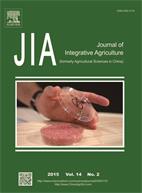|
|
G-protein β subunit AGB1 positively regulates salt stress tolerance in Arabidopsis
MA Ya-nan, CHEN Ming, XU Dong-bei, FANG Guang-ning, WANG Er-hui, GAO Shi-qing, XU Zhao-shi, LI Lian-cheng, ZHANG Xiao-hong, MIN Dong-hong, MA You-zhi
2015, 14(2):
314-325.
DOI: 10.1016/S2095-3119(14)60777-2
The heterotrimeric GTP-binding proteins (G-proteins) in eukaryotes consisted of α, β and γ subunits and are important in molecular signaling by interacting with G-protein-coupled receptors (GPCR), on which to transduce signaling into the cytoplast through appropriate downstream effectors. However, downstream effectors regulated by the G-proteins in plants are currently not well defined. In this study, the transcripts of AGB1, a G protein β subunit gene in Arabidopsis were found to be down-regulated by cold and heat, but up-regulated by high salt stress treatment. AGB1 mutant (agb1-2) was more sensitive to high salt stress than wild-type (WT). Compared with WT, the cotyledon greening rates, fresh weight, root length, seedling germination rates and survival rates decreased more rapidly in agb1-2 along with increasing concentrations of NaCl in normal (MS) medium. Physiological characteristic analysis showed that compared to WT, the contents of chlorophyll, relative proline accumulation and peroxidase (POD) were reduced, whereas the malonaldehyde (MDA) content and concentration ratio of Na+/K+ were increased in agb1-2 under salt stress condition. Further studies on the expression of several stress inducible genes associated with above physiological processes were investigated, and the results revealed that the expressions of genes related to proline biosynthesis, oxidative stress response, Na+ homeostasis, stress- and ABAresponses were lower in agb1-2 than in WT, suggesting that those genes are possible downstream genes of AGB1 and that their changed expression plays an important role in determining phenotypic and physiologic traits in agb1-2. Taken together, these findings indicate that AGB1 positively regulates salt tolerance in Arabidopsis through its modulation of genes transcription related to proline biosynthesis, oxidative stress, ion homeostasis, stress- and ABA-responses.
|
